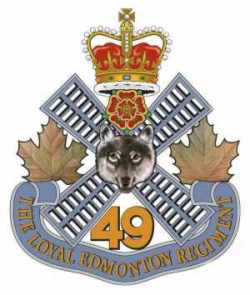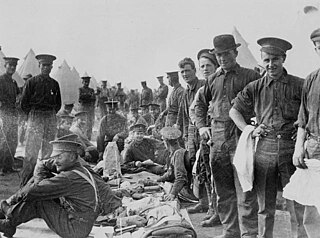Related Research Articles

The Loyal Edmonton Regiment, or LER, is a Primary Reserve infantry unit of the Canadian Forces based in Edmonton, Alberta. The LER is part of 3rd Canadian Division's 41 Canadian Brigade Group. They are colloquially known as "The Loyal Eddies".

The North Saskatchewan Regiment is a Primary Reserve infantry regiment of the Canadian Army, headquartered in Saskatoon, Saskatchewan, with companies in Saskatoon and Prince Albert. Its current commanding officer is Lieutenant-Colonel Dennis Sansom, and the regimental sergeant-major is Chief Warrant Officer Jason Balcaen. The N Sask R is part of the 3rd Canadian Division's 38 Canadian Brigade Group.
The 138th Battalion, CEF, was a unit in the Canadian Expeditionary Force during the First World War.
The 152nd Battalion, CEF, was a unit of the Canadian Expeditionary Force during the Great War. It was authorized on 22 December 1915, recruiting in Weyburn and Estevan, Saskatchewan, and embarked for Great Britain on 3 October 1916, where its personnel were absorbed by the 32nd Reserve Battalion, CEF, on 21 October 1916 to provide reinforcements for the Canadian Corps in the field. The battalion was disbanded on 21 May 1917.
The 195th Battalion, CEF was a unit in the Canadian Expeditionary Force during the First World War. Based in Regina, Saskatchewan, the unit began recruiting during the winter of 1915/16 in that city. After sailing to England in November 1916, the battalion was absorbed into the 32nd Reserve Battalion on November 11, 1916. The 195th Battalion, CEF had one Officer Commanding: Lieut-Col. A. C. Garner.
The 226th Battalion, CEF was a unit in the Canadian Expeditionary Force during the First World War. Based in Dauphin, Manitoba, the unit began recruiting in March of 1916 in the area of Dauphin and Minnedosa, Manitoba. After sailing to England in December 1916, the battalion was absorbed into the 14th Reserve Battalion on April 7, 1917. The 226th Battalion, CEF had one Officer Commanding: Lieut-Col. R. A. Gillespie.
The 232nd (Saskatchewan) Battalion, CEF was a unit in the Canadian Expeditionary Force during the First World War. Based in North Battleford, Saskatchewan, the unit began recruiting in early 1916 in that town and the surrounding district. After sailing to England in April 1917, the battalion was absorbed into the 15th Reserve Battalion on June 9, 1917. The 232nd (Saskatchewan) Battalion, CEF had one Officer Commanding: Lieut-Col. R. P. Laurie.

The Royal Regina Rifles is a Primary Reserve infantry regiment of the Canadian Army. Prior to 1982 the regiment was known as The Regina Rifle Regiment. The Royal Regina Rifles are part of 3rd Canadian Division's 38 Canadian Brigade Group.

The Saskatchewan Dragoons is a Primary Reserve armoured regiment of the Canadian Army. The unit is based in Moose Jaw. Their primary job is to assist the Regular Force in meeting Canada's military commitments. Their training and equipment closely follow that of the Regular Force, which the Reserves are called upon to assist increasingly often. The Saskatchewan Dragoons are part of 3rd Canadian Division's 38 Canadian Brigade Group.

The 12th Manitoba Dragoons is an armoured regiment of the Canadian Army that is currently on the Supplementary Order of Battle.
The 12th Battalion, CEF was an infantry battalion of the First World War Canadian Expeditionary Force. It was authorized on 10 August 1914 and embarked for Britain on 30 September 1914, where it was redesignated the 12th Reserve Infantry Battalion, CEF on 29 April 1915, to provide reinforcements for the Canadian Corps in the field. The battalion was reduced during the summer of 1916 and ultimately dissolved. Its residual strength was absorbed on 4 January 1917 into a new 12th Reserve Battalion, upon re-organization of the reserve units of the Canadian Infantry. The battalion was officially disbanded on 30 August 1920.
The 1st Battalion, Canadian Mounted Rifles, CEF, was an infantry battalion of the Canadian Army. Raised for service during the First World War as part of the Canadian Expeditionary Force (CEF), it was formed in November 1914, in Brandon, Manitoba. Originally a mounted infantry unit named the 1st Regiment, Canadian Mounted Rifles, CEF, which was expanded, following its rerolling and dismounting as an infantry unit, by absorbing other units of the Canadian Mounted Rifles (CMR).

The 5th Battalion, CEF, known as "Tuxford's Dandys," was an infantry battalion of the Canadian Expeditionary Force during the Great War.
The 6th Battalion, CEF was a battalion of the Canadian Expeditionary Force during the First World War. It was authorized on 10 August 1914, and embarked for Britain on 29 September 1914. It formed the nucleus of the Remount Depot on 20 January 1915, and the remainder of the battalion's personnel were absorbed by the Canadian Cavalry Depot, CEF, on 6 March 1915 to provide reinforcements for the Canadian Corps in the field. The battalion was disbanded on 5 April 1918.

The 11th Battalion, CEF, an infantry battalion of the Canadian Expeditionary Force, was authorized on 10 August 1914 and embarked for Great Britain on 30 September 1914. It was redesignated as the 11th Reserve Infantry Battalion, CEF, on 29 April 1915, to provide reinforcements to the Canadian Corps in the field. On 4 January 1917, its personnel, along with the personnel of the 100th Battalion, CEF, were absorbed by a new 11th Reserve Battalion (Manitoba), CEF. The battalion was disbanded on 12 October 1917.

The Irish Fusiliers of Canada was an infantry regiment of the Canadian Army. It was placed on the Supplementary Order of Battle in 1965. In 2002, it was taken off the Supplementary Order of Battle and amalgamated with The British Columbia Regiment.

The 46th Battalion, CEF, was an infantry battalion of the Canadian Expeditionary Force during the Great War. The 46th Battalion was authorized on 7 November 1914 and embarked for Britain on 23 October 1915. On 11 August 1916 it disembarked in France, where it fought with the 10th Infantry Brigade, 4th Canadian Division in France and Flanders until the end of the war. The battalion was disbanded on 30 August 1920.
The 65th Battalion (Saskatchewan), CEF was an infantry battalion of the Canadian Expeditionary Force during the Great War. The 65th Battalion was authorized on 20 April 1915 and embarked for Great Britain on 18 June 1916. Its personnel were absorbed by the 44th Battalion (Manitoba), CEF, 46th Battalion, CEF, 54th Battalion (Kootenay), CEF and 72nd Battalion, CEF of the 4th Canadian Division on 30 June 1916. The battalion was disbanded on 12 October 1917.
The Saskatchewan Mounted Rifles was a cavalry regiment of the Non-Permanent Active Militia of the Canadian Militia. First formed in 1908 as the Saskatchewan Light Horse, the regiment was later Redesignated that year as the 22nd Saskatchewan Light Horse and again in 1920 as The Saskatchewan Mounted Rifles. In 1936, the regiment was amalgamated with the 16th Canadian Light Horse to form the 16th/22nd Saskatchewan Horse.
The South Saskatchewan Regiment was a short-lived infantry regiment of the Non-Permanent Active Militia of the Canadian Militia. In 1924, the regiment was reorganized and split up into 5 separate regiments.
References
- ↑ Barrett, Matthew K. (2015-05-01). "The Giant". World War Graphic History. Retrieved 2022-07-19.
- ↑ Appendix to General Order No. 123 of 1929
- ↑ Canadian Forces Publication A-DH-267-003 Insignia and Lineages of the Canadian Forces. Volume 3: Combat Arms Regiments.